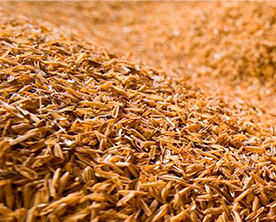One of the biggest challenges of developing countries is to provide for its poorer sections, and find ways out of poverty to raise the general standard of living of its people. This requires ensuring food for all by increasing agricultural output through a series of changes including the use of quality seeds, mechanizing systems and processes according to the latest available technology and expertise available
Countries like Myanmar are blessed with valuable fertile land and abundant rainfall, two of the most essential prerequisites for enhanced agricultural output. It is also the ideal place to cultivate rice which requires abundant water resources, and justifiably then, rice is the main agricultural crop, exported globally, and its output steadily increasing, to meet both the increasing domestic demand and for earning foreign exchange through international trade.
As output increases, the byproducts of this produce also increase, many requiring environmentally friendly ways of disposal that neither occupy space or cost too much to transport, nor pollute the air. All agricultural produce is not fully utilized, and some waste byproducts always require utilization and disposal. Biodegradable products go back into the soil and aid cultivation, and others by products are being innovatively used to create products that can serve human society in some way or other. Rice is the main agricultural product in Myanmar and the processing of rice paddy yields large quantities of rice husk, also called the hull or chaff. Rice husk is the outermost covering layer that protects the grain of rice.
Once paddy is harvested, rice husk forms 20% of the crop’s volume that is both bulky and cumbersome since it occupies too much space and potentially expensive to transport. In earlier times, rice husk was treated as a waste product that was a farmers’ nightmare to get rid of, simply because of its large volume. However, its multiple uses now make it a traded commodity that just has to be transported.
Characteristics of Rice Husk
Rice husk is light in weight, yellowish in color and convex in shape, slightly larger than the rice grain. It is separated from the brown rice grain as part of the milling process, after which the rice is polished. Forming one fifth of the volume of paddy, it is bulky and hence difficult to store. Some of its distinctive features include:
- Husk makes for good insulation material since it does not burn easily till air is blown through it. It is highly resistant to the penetration of moisture and fungal decomposition.
- Rice husk decomposes slowly due to the rich silica content, and can therefore not be considered for use as fodder.
- When rice husk is burned, its ash content of 17 – 26 % is far higher than that of wood and coal. This explains the need for much larger volumes of husk when utilized for power generation.
- Its high calorific value makes it a good source of renewable energy.
Potentially Beneficial uses of Rice Husk
The sheer volume of rice husk makes it difficult to store and its removal a challenge. Burning it only pollutes the air though it yields rice husk ash, or carbonized rice husk if not completely burned. Some of the many uses of rice hus that have developed over time include:
- Use in horticulture for soil aeration – Rice husk is being added to soil on the recommendation of scientists to improve soil aeration. Husk with its rich reserves of potassium and silicon helps to amend the soil, improve its properties by decreasing soil bulk density, improve its fertility with the air pockets created underground, and works like a rice conditioner.
- For making animal bedding – one of the simpler uses of husk is to convert them into bales which provide cushioned animal bedding. Its anti-caking properties make it easier to clean and maintain. It also serves as a good insulator.
- Composites like particle boards- Composite materials are produced by combining two or more materials that serve to enhance the properties of the original. The silica intrinsically found in rice husk makes it an ideal addition to panel and particle boards to make them stronger and resilient while remaining light in weight
- Using its silica – Husk contains three fourths of organic volatile matter and the balance is converted into RHA or rice husk ash. RHA contains nearly 90% of amorphous silica, that is excellent for reinforcing rubber tyres, can be used as an anti-caking agent, and for strengthening of building material.
- Renewable fuel – Rice husk is being increasingly used as biomass that fuels and co-fuels power plants. There are now a large number of power plants in Asia that are completely powered by ground rice husk.
- Insulation- Rice husk is considered to be a top class insulating material since it is difficult to burn and does not easily absorb moisture. It can be used as insulation powder in steel mills.
- Building material- The amorphous silica contained in rice husk ash helps to strengthen materials, and this is why there is a spiraling demand for it in the production of cement and concrete mixes, and low permeability concrete used for construction of bridges, nuclear plants, and in marine environments.
- Generating steam in rice mills- One of the most common uses is in the rice mills itself where husk is used as fuel to generate steam for the parboiling process of rice, which is consumed by the poorer sections of society.
Rice Husk put to use in Myanmar
Myanmar produces over 13 million tons of rice per annum on approximately half of the country’s arable land. This means that around 2.6 million tons of rice husk is generated annually, to be used or disposed of. While it was earlier a mammoth task to get rid of this voluminous waste, for the last 15 years, it has been put to use in a few limited ways. However, with more research and the numerous uses being discovered, of this silica rich material, Myanmar stands to benefit even as it accepts technical knowhow from countries like Japan and Thailand.
It is extensively used as fuel for steam engines used to power rice mills with belt transmissions since electricity is not available in all parts of the country. This serves as excellent fuel at reasonable rates and rice husk gasifiers are drawing attention since they can power small applications between 10 and 200 kilowatts when combined with an internal combustion engine to drive a generator. In a country where electrification is only around 26%, these gasifiers can prove to be complete power sources for villages where electrification is a distant dream.
With technical expertise and assistance from Thailand, rice husk is being used as biomass for electricity generation. To start with, Da Goon Daing, a small village 50 kilometers away from Yangon which has 300 houses and a total of 1500 residents, is being electrified to provide basic electricity uses like lights, fans and television sets. The reason behind selection of this village is the three rice mills in its vicinity that provide ample quantities of rice husk, that does not need to be transported elsewhere.
Myanmar is getting aid and support from countries like Japan to generate cleaner fuels. The use of rice husk to be converted into methane type fuel with the aid of biomass gasifiers creates toxic ash that pollutes the waterways and clogs the machinery in use. A Japanese NGO, The New Energy and Industrial Technology Development Organization (NEDO), has helped create a fuel that is perhaps an intermediate between raw rice husk and gasifiers that are more environmentally friendly. These rice briquettes and charcoal provide are more energy efficient than raw husk with a higher caloric content as well. NEDO currently has eleven projects in Myanmar, related to the environment and energy fields
Another 1000 kw biomass gasification power plant has been installed in one of the bigger rice mills. Efforts are being made to use this resource more extensively to meet the basic electricity needs of the people in remote areas. Approximately 1 metric ton of rice husk is required to be able to generate 1 MWh of power. With a few million tons of husk available, a huge amount of electricity can be generated to meet at least, simple domestic needs










